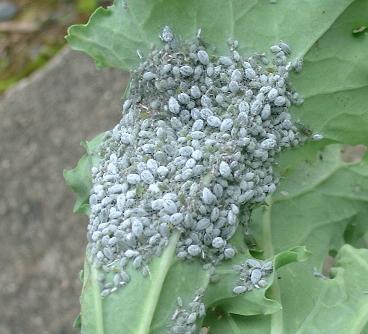There are over 500 species in Britain, fortunately only a few are garden pests; most are specific to one or two plant species. The Peach - potato aphid (Myzus persicae) is the green one which is most often seen on a wide range of plants, but can range in colour from yellow, all shades of green, to pink, red and almost black. There are root aphids which attack below ground and with a severe infestation will kill the plant by removing the sap before it can rise up the stem. They are white and waxy, giving them the appearance of a fungus.

Mealy Cabbage Aphids (Brevicoryne brassicae)
They can be carried for hundreds of miles by wind or air currents, and can transfer viruses as they move to other plants.
They need to suck up copious amounts of sap to obtain the small amounts of protein it contains. The excess, which contains sugars is flicked from their bottoms and is given the appetizing name of honeydew. This sticks to leaves and can be colonised by Sooty Mould, which reduces the amount of light reaching the photosynthesising cells, so further weakening the plant. They are attracted by the pale yellowish-green of young shoots where they know there is plenty of sap in tissues which are easily penetrated.
One species infests most Lime trees where they are joined by Scale insects which add to the problem - the honeydew can usually be seen on parked cars and plants below them. Some colonies of Ants 'herd' the aphids and collect the honeydew to feed their larvae; they protect the aphids and carry them to overwinter in their nests.
Aphids release a pheromone when they are threatened which warns others around them to move away or hide. A new type of wheat has been developed by genetic modification which can make the same chemical, so the aphids keep away from the plants. It has been effective under laboratory conditions, but field trials have yet to be carried out. It is hoped that this will be a more environmentally acceptable method than using pesticides.
In spring and summer only females are present reproducing asexually by a process known as parthenogenesis, giving birth to live young. In the autumn, males are produced and after mating the females lay eggs which remain through the winter in crevices. The population can double in 4 - 6 days; starting with one aphid, after one year of uninterrupted reproduction in perfect conditions would produce 250 million tons if none died! This means that they are a good source of food to other creatures including Ladybirds and their larvae, lacewings, hoverfly larvae and parasitic wasps.
Treatments
Back to GARDEN CREATURES